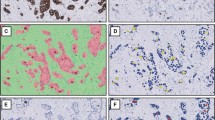Abstract
Manual estimation of Ki67 Proliferation Index (PI) in breast carcinoma classification is labor intensive and prone to intra- and interobserver variation. Standard Digital Image Analysis (DIA) has limitations due to issues with tumor cell identification. Recently, a computer algorithm, DIA based on Virtual Double Staining (VDS), segmenting Ki67-positive and -negative tumor cells using digitally fused parallel cytokeratin (CK) and Ki67-stained slides has been introduced. In this study, we compare VDS with manual stereological counting of Ki67-positive and -negative cells and examine the impact of the physical distance of the parallel slides on the alignment of slides. TMAs, containing 140 cores of consecutively obtained breast carcinomas, were stained for CK and Ki67 using optimized staining protocols. By means of stereological principles, Ki67-positive and -negative cell profiles were counted in sampled areas and used for the estimation of PIs of the whole tissue core. The VDS principle was applied to both the same sampled areas and the whole tissue core. Additionally, five neighboring slides were stained for CK in order to examine the alignment algorithm. Correlation between manual counting and VDS in both sampled areas and whole core was almost perfect (correlation coefficients above 0.97). Bland–Altman plots did not reveal any skewness in any data ranges. There was a good agreement in alignment (>85 %) in neighboring slides, whereas agreement decreased in non-neighboring slides. VDS gave similar results compared with manual counting using stereological principles. Introduction of this method in clinical and research practice may improve accuracy and reproducibility of Ki67 PI.







Similar content being viewed by others
References
Scholzen T, Gerdes J (2000) The Ki-67 protein: from the known and the unknown. J Cell Physiol 182:311–322. doi:10.1002/(SICI)1097-4652(200003)182:3<311:AID-JCP1>3.0.CO;2-9
de Azambuja E, Cardoso F, de Castro G et al (2007) Ki-67 as prognostic marker in early breast cancer: a meta-analysis of published studies involving 12,155 patients. Br J Cancer 96:1504–1513. doi:10.1038/sj.bjc.6603756
Bosman FT, Carneiro F, Hruban R, Theise N (2010) Classification of tumours of the digestive system. WHO, Lyon
Bettini R, Boninsegna L, Mantovani W et al (2008) Prognostic factors at diagnosis and value of WHO classification in a mono-institutional series of 180 non-functioning pancreatic endocrine tumours. Ann Oncol 19:903–908. doi:10.1093/annonc/mdm552
Goldhirsch A, Wood WC, Coates AS (2011) Strategies for subtypes–dealing with the diversity of breast cancer: highlights of the St. Gallen International Expert Consensus on the Primary Therapy of Early Breast Cancer 2011. Ann Oncol 22:1736–1747. doi:10.1093/annonc/mdr304
Goldhirsch A, Winer EP, Coates AS (2013) Personalizing the treatment of women with early breast cancer: highlights of the St Gallen International Expert Consensus on the Primary Therapy of Early Breast Cancer 2013. Ann Oncol 24:2206–2223. doi:10.1093/annonc/mdt303
Shui R, Yu B, Bi R et al (2015) An interobserver reproducibility analysis of Ki67 visual assessment in breast cancer. PLoS ONE 10:e0125131. doi:10.1371/journal.pone.0125131
Mikami Y, Ueno T, Yoshimura K et al (2013) Interobserver concordance of Ki67 labeling index in breast cancer: Japan Breast Cancer Research Group Ki67 ring study. Cancer Sci 104:1539–1543. doi:10.1111/cas.12245
Polley M-YC, Leung SCY, McShane LM et al (2013) An international Ki67 reproducibility study. J Natl Cancer Inst 105:1897–1906. doi:10.1093/jnci/djt306
Polley M-YC, Leung SCY, Gao D et al (2015) An international study to increase concordance in Ki67 scoring. Mod Pathol 28:778–786. doi:10.1038/modpathol.2015.38
Laurinavicius A, Plancoulaine B, Laurinaviciene A et al (2014) A methodology to ensure and improve accuracy of Ki67 labelling index estimation by automated digital image analysis in breast cancer tissue. Breast Cancer Res 16:R35. doi:10.1186/bcr3639
Tuominen VJ, Ruotoistenmäki S, Viitanen A et al (2010) Immunoratio: a publicly available web application for quantitative image analysis of estrogen receptor (ER), progesterone receptor (PR), and Ki-67. Breast Cancer Res 12:R56. doi:10.1186/bcr2615
Fasanella S, Leonardi E, Cantaloni C et al (2011) Proliferative activity in human breast cancer: ki-67 automated evaluation and the influence of different Ki-67 equivalent antibodies. Diagn Pathol 6(Suppl 1):S7. doi:10.1186/1746-1596-6-S1-S7
Gudlaugsson E, Klos J, Skaland I et al (2013) Prognostic comparison of the proliferation markers (mitotic activity index, phosphohistone H3, Ki67), steroid receptors, HER2, high molecular weight cytokeratins and classical prognostic factors in T1−2N0M0 breast cancer. Pol J Pathol 64:1–8
Nielsen PS, Riber-Hansen R, Jensen TO et al (2013) Proliferation indices of phosphohistone H3 and Ki67: strong prognostic markers in a consecutive cohort with stage I/II melanoma. Mod Pathol 26:404–413. doi:10.1038/modpathol.2012.188
Gundersen HJ, Bendtsen TF, Korbo L et al (1988) Some new, simple and efficient stereological methods and their use in pathological research and diagnosis. APMIS 96:379–394
Narbe U, Bendahl P-O, Grabau D et al (2014) Invasive lobular carcinoma of the breast: long-term prognostic value of Ki67 and histological grade, alone and in combination with estrogen receptor. Springerplus 3:70. doi:10.1186/2193-1801-3-70
Alvarenga CA, Paravidino PI, Alvarenga M et al (2012) Reappraisal of immunohistochemical profiling of special histological types of breast carcinomas: a study of 121 cases of eight different subtypes. J Clin Pathol 65:1066–1071. doi:10.1136/jclinpath-2012-200885
Sterio DC (1984) The unbiased estimation of number and sizes of arbitrary particles using the disector. J Microsc 134:127–136
Author information
Authors and Affiliations
Corresponding author
Ethics declarations
Ethical standards
All experiments in this article were performed in accordance to Danish law.
Conflicts of interest
RR and MV have collaborated with Visiopharm in the development of the software. MV is member of the Visiopharm Scientific Advisory Board. The remaining authors declare that they have no conflict of interest.
Disclosures
None.
Rights and permissions
About this article
Cite this article
Røge, R., Riber-Hansen, R., Nielsen, S. et al. Proliferation assessment in breast carcinomas using digital image analysis based on virtual Ki67/cytokeratin double staining. Breast Cancer Res Treat 158, 11–19 (2016). https://doi.org/10.1007/s10549-016-3852-6
Received:
Accepted:
Published:
Issue Date:
DOI: https://doi.org/10.1007/s10549-016-3852-6




